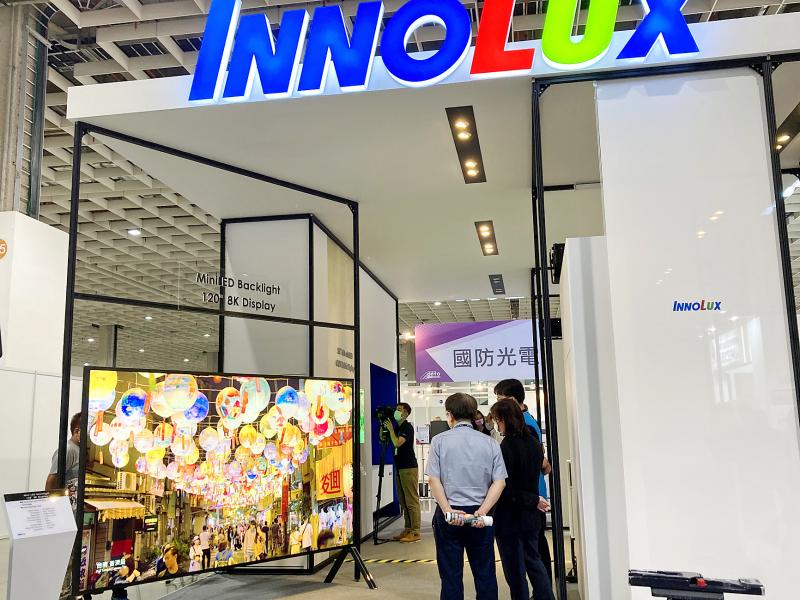LCD panel maker Innolux Corp (群創) yesterday said it is bullish about panel demand over next 12 months as the COVID-19 pandemic continues to drive demand for notebook computers, tablets and TVs.
The Miaoli County-based company said that the pandemic has boosted demand for electronic devices as workers and students increasingly work and study remotely, leading to strong revenue growth and portending a profitable quarter for the panel maker.
Innolux has posted losses for the past seven quarters.

Photo: Lisa Wang, Taipei Times
“Our competitors have said that strong orders will extend through December, and even to the first quarter of next year, but we are confident to say that our business outlook is even better than that,” company chairman Jim Hung (洪進揚) told a media briefing in Taipei.
“We believe that the stay-at-home economy will drive a sustainable growth, even during the post-pandemic era,” Hung said. “We are bullish about our business outlook. For the whole of next year, demand will not be a problem.”
Laptops, tablets, TVs and other devices benefit from this wave of demand, Hung said.
As a result, the industry is in a healthy condition due to balanced demand and supply for LCD panels as Samsung Electronics Co phases out panel production, he said.
The prices of 55-inch TV panels jumped 6.9 percent per unit this month from the prior month due to tight supply, while panels for notebook computers climbed 3.2 percent, TrendForce Corp (集邦科技) data released on Tuesday showed.
This quarter, prices of large flat panels would surge 10 percent from the previous quarter, TrendForce said, adding that supply crunch of driver integrated circuits used in displays and chips poses a problem for shipments of certain panels.
Innolux would try to satisfy demand primarily for panels used in information technology applications, Innolux vice president James Yang (楊柱祥) said.
Innolux yesterday unveiled its first flat-panel satellite antenna in collaboration with Kymeta Corp, which has received funds from Microsoft Corp founder Bill Gates and other investors.
Innolux said it has assumed shipments to US customers of the antennas, which can be installed on aircraft, vehicles or boats to access the Internet through a satellite connection.
The new product is crucial for Innolux, allowing it to rejuvenate older and less advanced fabs to produce new products, said Ting Chin-lung (丁景隆), head of Innolux’s technology development center.
The company expects large-scale adoption of its antennas within the next five years.
Innolux said that demand would increase gradually after Space Exploration Technologies (SpaceX), founded by Tesla Inc chief executive Elon Musk, by the end of this year assumes providing Internet connectivity services through the company’s low Earth orbit satellites.
Facebook Inc and Amazon.com Inc are also building their own low Earth satellite networks, indicating a significant growth potential for the technology, Ting said.

TECH BOOST: New TSMC wafer fabs in Arizona are to dramatically improve US advanced chip production, a report by market research firm TrendForce said With Taiwan Semiconductor Manufacturing Co (TSMC, 台積電) pouring large funds into Arizona, the US is expected to see an improvement in its status to become the second-largest maker of advanced semiconductors in 2027, Taipei-based market researcher TrendForce Corp (集邦科技) said in a report last week. TrendForce estimates the US would account for a 21 percent share in the global advanced integrated circuit (IC) production market by 2027, sharply up from the current 9 percent, as TSMC is investing US$65 billion to build three wafer fabs in Arizona, the report said. TrendForce defined the advanced chipmaking processes as the 7-nanometer process or more

China’s Huawei Technologies Co (華為) plans to start mass-producing its most advanced artificial intelligence (AI) chip in the first quarter of next year, even as it struggles to make enough chips due to US restrictions, two people familiar with the matter said. The telecoms conglomerate has sent samples of the Ascend 910C — its newest chip, meant to rival those made by US chipmaker Nvidia Corp — to some technology firms and started taking orders, the sources told Reuters. The 910C is being made by top Chinese contract chipmaker Semiconductor Manufacturing International Corp (SMIC, 中芯) on its N+2 process, but a lack

Who would not want a social media audience that grows without new content? During the three years she paused production of her short do-it-yourself (DIY) farmer’s lifestyle videos, Chinese vlogger Li Ziqi (李子柒), 34, has seen her YouTube subscribers increase to 20.2 million from about 14 million. While YouTube is banned in China, her fan base there — although not the size of YouTube’s MrBeast, who has 330 million subscribers — is close to 100 million across the country’s social media platforms Douyin (抖音), Sina Weibo (新浪微博) and Xiaohongshu (小紅書). When Li finally released new videos last week — ending what has

NVIDIA PLATFORM: Hon Hai’s Mexican facility is to begin production early next year and a Taiwan site is to enter production next month, Nvidia wrote on its blog Hon Hai Precision Industry Co (鴻海精密), the world’s biggest electronics manufacturer, yesterday said it is expanding production capacity of artificial intelligence (AI) servers based on Nvidia Corp’s Blackwell chips in Taiwan, the US and Mexico to cope with rising demand. Hon Hai’s new AI-enabled factories are to use Nvidia’s Omnivores platform to create 3D digital twins to plan and simulate automated production lines at a factory in Hsinchu, the company said in a statement. Nvidia’s Omnivores platform is for developing industrial AI simulation applications and helps bring facilities online faster. Hon Hai’s Mexican facility is to begin production early next year and the